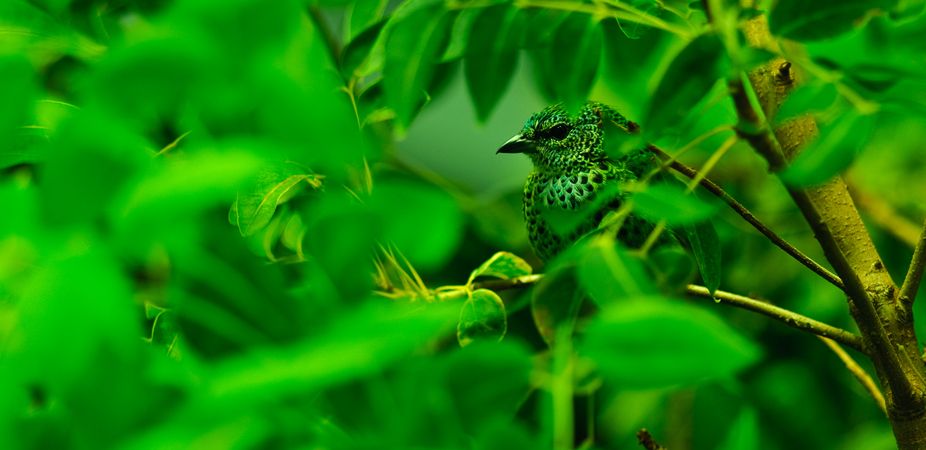
Why One Hectare of Rainforest Grows More Tree Species than US

This article was originally published at The Conversation. The publication contributed the article to LiveScience's Expert Voices: Op-Ed & Insights.
One hectare of land in a tropical forest can hold 650 tree species – more than in all of Canada and the continental US. This has left biologists baffled for decades. Now, with advances in data analysis, Phyllis Coley and Thomas Kursar of the University of Utah may have finally found an explanation.
From a broad perspective, evolution is pretty simple. Successful species survive and reproduce, which depends on how readily they obtain resources. So if two species are too similar in their use of resources, they would compete with each other – unless one evolves to use a different resource and exploits a niche that hasn’t been filled. However, in any environment, niches are limited. That is why the diversity in a tropical forest cannot be explained by the exploitation of niches alone.
The competition for niches is shaped by species’ interactions with the environment, which includes both abiotic elements (climate, water, soil and such) and biotic elements (in other words, other species). Tropical forests have stable abiotic environments, so Coley and Kursar concluded it must be the biotic interactions that explain the extraordinary diversity in these forests.
They argue, in an article just published in Science, that an arms race between plants and plant-eaters is what drives evolutionary changes. When a plant-eater finds a new way to attack a plant, the plant must evolve to fight the plant-eater. Through many generations these changes force formation of new species, leading to the observed tropical diversity.
This explanation is known as the Red Queen hypothesis, which gets its name from a statement the Red Queen made to Alice in Lewis Carroll’s “Through the Looking-Glass”:
Now, here, you see, it takes all the running you can do, to keep in the same place.
The Red Queen Hypothesis is not new. It was first suggested in 1973, and has been applied to many other ecological scenarios. However, so far, biologists have found it hard to determine whether it applies to tropical forests because of the sheer size of the task. Tropical forests have thousands of plant species that may have hundreds of plant-eaters each. These millions of interactions need to be all taken into account to show the Red Queen hypothesis at work.
Sign up for the Live Science daily newsletter now
Get the world’s most fascinating discoveries delivered straight to your inbox.
Also, in such an arms race, plants have it harder than herbivores, because their lifespan can be hundreds of times longer than the average leaf-eater, which is usually a small insect. That is why a single tropical tree may have hundreds of distinct chemical compounds in its defence arsenal against herbivores, which makes the analysis harder.
This is where advances in data analysis prove handy. To understand these defences on an ecosystem scale requires the use of metabolomics, which is the study of chemical fingerprints left behind by an organism.
Metabolomic analyses across forests in Mexico, the Amazon and Panama, show that neighbouring plants mostly have different defences than would be expected if it were a random process – in other words the Red Queen seems to be in action. Most convincingly, closely related trees and shrubs have often diverged defences, which is a sign of exploring biotic interaction niches, but have similar non-defence traits, which results from similar abiotic conditions that they find themselves in.
Coley said that, while the data seems convincing, there are still limitations. Tropical forests have been studied well, but there is no comparable data from the temperate regions, which would be needed as a control to validate the hypothesis. Perhaps such an arms race also occurs in temperate regions that have been studied less. Also, temperate regions are purported to have fewer interactions (in types and total numbers) between trees and herbivores, but that may not actually be true, according to Jeff Ollerton, professor of biodiversity at the University of Northampton.
In a 2011 study published in the journal Functional Ecology, Angela Moles, the head of the Big Ecology Lab at the University of New South Wales, looked at all the data on interactions between plants and plant-eaters. She found only a third of the studies showed there to be more interactions among tropical species than those at higher latitudes, such as temperate regions. But this meta-analysis (a method to meaningfully compare different datasets) showed that the positive results are not statistically significant. Worse still, only nine out of 56 comparisons showed that chemical defences were higher in tropical plants than in temperate ones.
Also, some recent work has called out biologists for depending on the Red Queen hypothesis for many explanations. A small but vocal group of researchers argue that other processes can explain diversity. Chief among the alternate explanations is the idea of genetic drift, where some genetic mutations are passed on to progeny randomly. This differs from natural selection, where nature actively chooses which mutations get passed on.
While Coley remains confident that the Red Queen hypothesis will indeed prove to be a satisfactory explanation, she also knows that a lot more data will be needed to get there. Previously, the limitation was data analysis; now it is data collection. Researchers have no option but to go out in a tropical forest, search for plants and their herbivores, and then record their interactions.
While other explanations will certainly have some role to play, Coley and Kursar make a persuasive case for why nature seems to have endowed tropical regions with so many plant and plant-eating species. Although Alice may not like it, we may have to thank the Red Queen for it.
This article was originally published at The Conversation. Read the original article. The views expressed are those of the author and do not necessarily reflect the views of the publisher. This version of the article was originally published on LiveScience.











